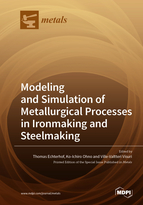Experimental and Numerical Investigations on Charging Carbon Composite Briquettes in a Blast Furnace
Round 1
Reviewer 1 Report
Detailed comments are annotated in the attached copy of the manuscript.
Comments for author File: ![]() Comments.pdf
Comments.pdf
Author Response
Please see the attachment
Author Response File: ![]() Author Response.pdf
Author Response.pdf
Reviewer 2 Report
Dear Authors,
your paper "Experimental and Numerical Investigations on Charging Carbon Composite Briquette in Blast Furnace" discusses about the benefits of charging CCB in replacement to iron ore on coke consuption, productivity, top gas temperature in blast furnace ironmaking. The investigation is made by numerical simulation with a fluiddynamic, chemical and thermodynamic code. Some of the inputs were obtained experimentally by thermal analysis on CCB.
The paper is well structured. The model description is detailed enough and the references cited along the manuscript indicate a long tradition in simulation of thermochemical processess.
I have some minor request to ameliorate the quality of your paper:
a) Line 46-47: Could the Authors briefly summarize the heat treatment condition of produced CCB? I understand the whole process is reported in their previous work (ref. 24) but the salient aspect of how to obtain the investigated CCB must be reported also in this work.
b) line 48-50: in the same way as before, please include a brief description about the CCB behaviour. Few rows are enough to explain how a CCB works when heated and this is important to figuring out the entire process when 10% on ore mass of CCB is charged in a BF.
c) line 68-69: also here it would be better to list the raw materials used in CCB manufacturing.
d) Table 1. Please, add also the basicity of your CCB.
e) Figure 2: why the streamline is supposed to not be linear, i.e. it does not descend linearly from top to heart of the BF? It is dependent on the volume expansion of the ores when heated?
f) Figure 4: please add to Figure 4 also the condition of Case A, to hava a better comparison among the two processes.
g) Line 232-233: please, add in Figure 4 also the same BF section but without the CCB to better highlight the difference with traditional iron ores
h) What about the CO2 emissions? From your analysis it seems that the CO2 will increase due to the use of CCB. This is in the opposite trend with respect the requirement of society. However, the reduction of coke consumption is considerable. Thus, my question is: "comparing all the CO2 sources (briquetting and heat treating of CCB, CO2 increase in the top gas, coke reduction), in which direction is moved the CO2 footprint of the process?". I think this aspect is mandatory to be explored in your research.
Best Regards
Author Response
Please see the attachment
Author Response File: ![]() Author Response.pdf
Author Response.pdf
Reviewer 3 Report
This paper numerically investigated the effect of charging Carbon Composite Briquette on the BF inner states and global performance indicators. The results indicated the coke saving potential of CCB charging in blast furnace. However, the following aspects are needed to be clarified before the draft can be accepted:
- The authors should describe how the liquid phase is treated in the current BF model. This is because the liquid treatment is closely related to the heat balance of the BF lower part, and also closely related to the coke rate prediction.
- Following the 1st question, how to predict the coke rate in the current BF model framework? What is the criteria to determine coke rate? Please describe it in detail.
- Line 138-139 “For ensuring a stable solid flow, the reaction rate of the coke is not included in Table 4”. Please explain it more detail.
- Line 241-245. How to distinguish the “CO potential in CCB” and the “CO potential in BF gas”? These two terms are a bit confusing since there is only one gas phase in the BF. Please give more detailed definition of these two terms.
- In Table 7, the illustration of Fuel rate in Case B is not clear.
- The authors should clearly illustrate the reaction kinetics difference between ore/coke particles and the CCB.
- In Table 6, please also give more detailed information of ore components and coke components.
- In Table 6, the coke supply rate in Case B is the model output?
Author Response
Please see the attachment.
Author Response File: ![]() Author Response.pdf
Author Response.pdf





